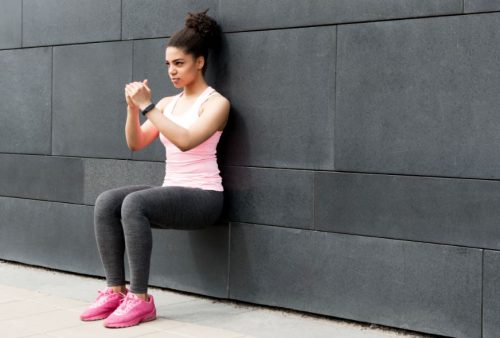Isometric Squats: A Guide for All Levels

Isometric exercise is when you activate your muscles without moving or doing repetitions, as is the case with the isometric squat. You can do them using weights or by just using your own body weight. There are different exercises that fit into this category and below we will look at isometric squats.
Isometric exercise: what is it and what is it for?
Before going into isometric squats, we would like to take a look at isometric exercise. It is an alternative to routine exercise and can improve your physical performance. Simply put, it is a way to activate your muscles without moving, contrary to cardio exercise and strength training with repetitions.

The best part is that you can combine isometric exercise with any traditional routine and improve your results. Isometric exercises are also perfect in the gym or at home. They strengthen muscles and do not cause muscle or joint injuries.
There are two types of isometric exercises – active and passive. Active exercises include pushing a wall or pulling on something that is anchored to the ground. Passive exercises include planks, static sit-ups, shoulder raises, and isometric squats.
Thanks to these exercises, you can focus on a specific objective, be it strengthening tendons or ligaments, developing strength in tissues, or increasing muscular strength. What’s more, the isometric aspect focuses on working your muscles, and helps you to bulk-up and get better results in your other exercise routines.
Note that isometric exercise raises blood pressure and is not recommended for those with heart conditions. Make sure you do the exercises steadily followed by a pause. Also, warming up beforehand is crucial.
Depending on your fitness level, you can hold a pose for five seconds or one minute, while always remembering to rest after each set. You can also use weights in isometric exercises. Make sure to keep your technique in mind as well as what weight is appropriate for you.
Doing isometric squats
This exercise is very effective, and though it looks simple, there are tricks to keep in mind to avoid exhaustion. Isometric squats do indeed activate muscles without movement and to give you a helping hand, you will be pressing your back against a wall.
You will work out your quadriceps, which are the muscles that support your entire body weight. Once you have done it many times and have mastered it, the next step is to add weight – a dumbbell in each hand would be enough.

But let’s not get ahead of ourselves; first, you will have to do a basic isometric squat. Stand with your back against the wall with your legs shoulder-width apart. Press your body against the wall, from your head to your glutes.
Slowly bend your knees, while lowering your torso. Your thighs should be parallel to the floor, with your knees forming a 90 degree angle. Place your arms next to your body with your feet planted on the ground. Hold this position for 30 seconds and rest for 20 seconds. Do this at least five times.
If this is too easy, you can try holding it for one minute. Or, take things up a notch: press only your back against the wall. In other words, press only with your shoulder blades, lower back, and glutes. Next, bend your knees, stand on your toes, and raise your arms in front of your body. Do these isometric squats for a least 30 seconds.
Once you have completed the routine, we recommend slowly standing up to avoid any dizziness. Take a few steps and stretch out your legs so your joints and muscles can become re-accustomed to movement.
Isometric exercise is when you activate your muscles without moving or doing repetitions, as is the case with the isometric squat. You can do them using weights or by just using your own body weight. There are different exercises that fit into this category and below we will look at isometric squats.
Isometric exercise: what is it and what is it for?
Before going into isometric squats, we would like to take a look at isometric exercise. It is an alternative to routine exercise and can improve your physical performance. Simply put, it is a way to activate your muscles without moving, contrary to cardio exercise and strength training with repetitions.

The best part is that you can combine isometric exercise with any traditional routine and improve your results. Isometric exercises are also perfect in the gym or at home. They strengthen muscles and do not cause muscle or joint injuries.
There are two types of isometric exercises – active and passive. Active exercises include pushing a wall or pulling on something that is anchored to the ground. Passive exercises include planks, static sit-ups, shoulder raises, and isometric squats.
Thanks to these exercises, you can focus on a specific objective, be it strengthening tendons or ligaments, developing strength in tissues, or increasing muscular strength. What’s more, the isometric aspect focuses on working your muscles, and helps you to bulk-up and get better results in your other exercise routines.
Note that isometric exercise raises blood pressure and is not recommended for those with heart conditions. Make sure you do the exercises steadily followed by a pause. Also, warming up beforehand is crucial.
Depending on your fitness level, you can hold a pose for five seconds or one minute, while always remembering to rest after each set. You can also use weights in isometric exercises. Make sure to keep your technique in mind as well as what weight is appropriate for you.
Doing isometric squats
This exercise is very effective, and though it looks simple, there are tricks to keep in mind to avoid exhaustion. Isometric squats do indeed activate muscles without movement and to give you a helping hand, you will be pressing your back against a wall.
You will work out your quadriceps, which are the muscles that support your entire body weight. Once you have done it many times and have mastered it, the next step is to add weight – a dumbbell in each hand would be enough.

But let’s not get ahead of ourselves; first, you will have to do a basic isometric squat. Stand with your back against the wall with your legs shoulder-width apart. Press your body against the wall, from your head to your glutes.
Slowly bend your knees, while lowering your torso. Your thighs should be parallel to the floor, with your knees forming a 90 degree angle. Place your arms next to your body with your feet planted on the ground. Hold this position for 30 seconds and rest for 20 seconds. Do this at least five times.
If this is too easy, you can try holding it for one minute. Or, take things up a notch: press only your back against the wall. In other words, press only with your shoulder blades, lower back, and glutes. Next, bend your knees, stand on your toes, and raise your arms in front of your body. Do these isometric squats for a least 30 seconds.
Once you have completed the routine, we recommend slowly standing up to avoid any dizziness. Take a few steps and stretch out your legs so your joints and muscles can become re-accustomed to movement.
This text is provided for informational purposes only and does not replace consultation with a professional. If in doubt, consult your specialist.








